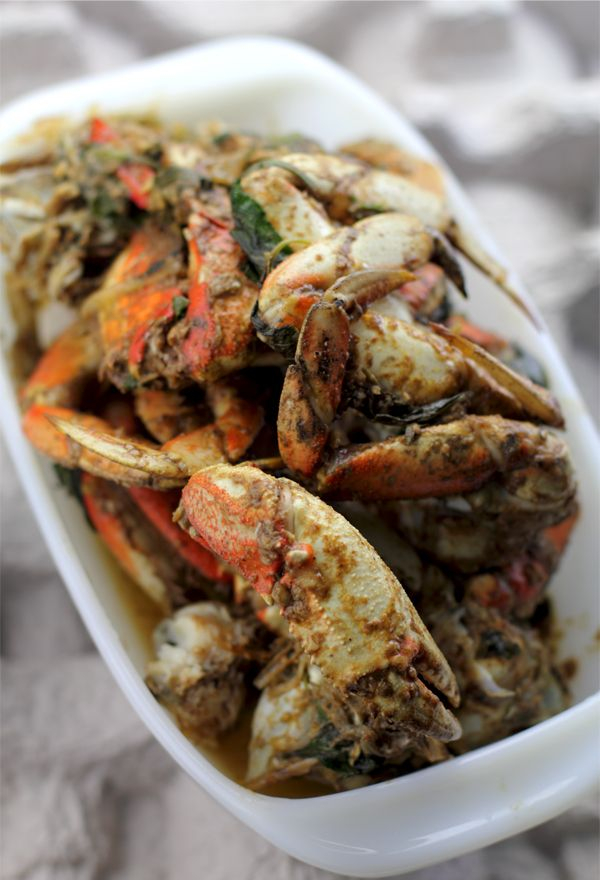When I went back to Paris last summer, Papa told me about their recent vacation to the magical islands of the French West Indies (Antilles francaises), Martinique and Guadeloupe. He told me about the food he ate there and about a particular dish he adored called Matété (also named Matoutou). It’s a spicy crab pilaf and its preparation is very similar to our Vietnamese crab cua rang muoi.
The difference from the Asian dish is the flavorings, which consist of fresh thyme, celery, flat-leaf parsley, bay leaves, green onions and fresh Scotch bonnet peppers. We planted hot chile seeds at the beginning of the summer and they’re just about ripe and ready to be cooked!
1. Info for Caribbean Crab Pilaf Recipe (Matete)
- Cook Time: 50 mins
- Total Time: 1 hr 35 mins
- Servings: 8
- Calories: 351 kcal
2. Ingredients for Caribbean Crab Pilaf Recipe (Matete)
- 6 whole fresh crabs
- 6 tablespoons canola oil
- 1 tablespoon tomato paste
- 4 cloves garlic, finely minced
- 2 teaspoons garlic powder
- 2 teaspoons salt
- 2 yellow onions, finely chopped
- 2 green onions, finely chopped
- 2 sprigs fresh thyme
- 1 celery stalk with leaves, finely chopped
- 1 fresh bay leaf, torn in half
- 2 limes, halved and juiced
- 2 teaspoons fresh Scotch bonnet peppers, stemmed, seeded and finely chopped
- 2 teaspoons granulated sugar
- 4½ cups fish stock (vegetable stock or water)
- 2 teaspoons black pepper, freshly ground
3. Directions:
- Clean the crabs, brush and rinse thoroughly. Separate the 2 main claws from each crab. Set aside.
- Remove and discard the abdominal flaps (the triangle-shaped tail). Lift and separate the back-fin with the rest of the claws by placing a large tablespoon at the bottom of the crab. Remove and discard the “lungs” (also known as Devil’s fingers; they have a spongy texture); they’re inedible. Gather the liquid, crab “butter” and corals from the inside of the crabs into a bowl. Discard the main shells.
- Using a cleaver, cut the back-fins in half and slightly crack the claws (see tips). Gather the pieces of crab in a large mixing bowl. Add the garlic powder, the juice of 1 lime, salt and 1 teaspoon of pepper. Toss well. Marinate for at least 15 minutes.
- In the same bowl containing the crab liquid, combine the chopped chiles and sugar.
- Slightly bruise the parsley leaves and coarsely chop them.
- In a large Dutch oven or heavy-bottomed pot, heat the oil. Add the yellow onions, green onions and thyme and cook until slightly golden and fragrant. Add the garlic and paprika. As soon as the garlic is lightly browned, add the crab pieces. Jiggle the pot to make sure the crab does not stick to the bottom and is totally coated with oil. Add the crab liquid mixture. Constantly toss the crab to ensure each piece is coated with the sauce. Add ½ to one cup of water and about 2 tablespoons of parsley leaves. Cover and cook for about 8-10 minutes, stirring often. The crab meat should be white and opaque and the liquid should be evaporated as well. Do not over-cook the crab; otherwise the meat will be dry! Uncover and add the remaining parsley leaves. Toss the crab and cook for another 2-3 minutes. Adjust the seasoning. Season with more salt (if necessary) and pepper. Transfer the crab to a platter.
- Add 1 more tablespoon of oil to the pot if necessary. Add the celery and bay leaf. Then add the rice to the pot. Make sure that each grain is coated with oil. Stir until light translucent. Add 3 cups of warm fish stock. Stir constantly. After bringing the liquid to a boil, add the tomato paste and lower the heat to medium-low; cook for about 20 to 30 minutes. Season with salt and pepper. Check the liquid and periodically add ½ cup to 1 cup of stock (and water if all the broth is used) when all the previous liquid is absorbed. Let simmer for another 10-15 minutes.
- Return the crab to the pot on top of the rice. Add 1 cup of boiling water. Drizzle with 1 lime juice and cover with 1 tablespoon parsley. Cover, bring to a boil, then let simmer for 5 minutes. Let sit for 10 minutes.
- Transfer to a large platter.
- Enjoy!
4. Tips and advices:
- It’s important to slightly crack the claws prior to cooking so that the spicy flavors permeate the crab. I use a hammer but you can also use the back of a knife; just make sure to crack the shell and not crush it. You don’t want to be eating bits of shell! (Note: we use our meat tenderizer mallet and it works great!).
- I always brush the crabs, rinse thoroughly and place them in the freezer (for about 45 minutes) prior to cutting them. If you have a better method, please share.
- It’s important to always keep the temperature of the stove at the highest setting. The higher the temperature, the better. If some solids start sticking to the bottom of the pot, add a little water.
- There are many varieties of high-starch rice such as Carnaroli, Baldo or Arborio rice but the latter is probably the most common kind for making rice pilaf.

